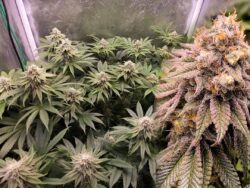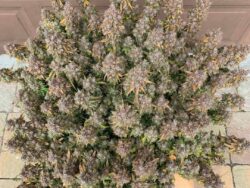Grown by StickyGreen from the UGC (Urban Growers Collective), pictures by Antonio
Successful Durban Poison indoor organic grow review despite Thrip infestation

| Variety | Durban Poison |
| Cannabis seed type | Feminised cannabis seeds |
| Number of seeds | 10 |
| Date of germination | September 2021 |
| Germination rate | 100% |
| Days required for germination | 4 days |
| Length of veg cycle (18/6 light schedule) | 9 weeks. First 2 weeks in a plug, 3 weeks in a small pot, 4 weeks in a big pot |
| Length of bloom cycle (12/12 light schedule) | 9 weeks (63-65 days) |
| Stretch during bloom | Stretchy, Sativa dominant hybrid, probably around 150% |

| Grow room type | Homebox Q60 |
| Grow room size | 60 x 60 x 160 cm |
| Plant numbers | 2 plants |
| Plant containers | 30L Airpot (7 Gallon) and 3 Gallon Rootpouch (12L) |
| Grow medium | Light mix soil:Coco fibre in a 4:1 ratio |
| Nutrients | Biotabs + BAC nutrients |
| Grow system | Watered by hand – soil/coco grow |
| Grow technique | Natural grow with cropping and super-cropping techniques |
| Grow light | 140W LED grow light with dimmer |
| Light distance to canopy | Around 20-30cm in bloom |
Durban Poison feminised seeds germinate successfully

We germinated 10 Durban Poison seeds in total. After 4 days all of the seeds had germinated which gave us a 100% germination rate. We left them in the cotton pad 1 day longer, so the young taproot grew a little larger than normal. So, 5 days after placing the seeds on the cotton pads it was time to transplant!
We usually use 0,25L containers but on this occasion we had to use Eazyplugs instead. These small plugs are perfect to germinate young seedlings as well as for clones.
Related:
Best method to germinate cannabis seeds – moist cotton pads
Remarks during vegetative phase – VEG (18/6 cannabis light cycle)

The young Durban Poison seedlings were pre-grown in these Eazyplugs for the first 10-11 days. Due to space restrictions, we had to use these smaller plugs during the first 2 weeks. During this time the medium became a bit too dry on one occasion through under-watering. Unfortunately, we lost one seedling because of this. So, after this phase there were still 9 young plants left.

We transplanted them into 0.25L containers after about 11 days. During this time the plants started to grow more vigorously and there seemed to be one plant that had some trouble keeping up with the rest.
In the end we chose to get rid of this lady as well. The next 2.5-3 weeks went quite fine, but we noticed the young plants were being attacked by a type of pest. Yes, we took a closer look with a microscope, and we found out that the small white dots (and stripes) on the leaves were caused by thrips!
We decided to spray the leaves with a special mixture of organic compounds to get rid of these pests. The ingredients of this spray put a layer on the leaves and stems that these young critters don’t like to taste.
It is partly being made from the banana plant and is not made of chemicals and thankfully not harmful to other living beings as well as humans.

So after about a total of 5 weeks of VEG we selected the 2 best looking plants to grow separately in a 60x60cm grow tent.
The other 6 plants were gifted to a friend which was happy to receive them and grew them alongside other plants in a different grow room.
Because these Durban Poison plants are photoperiod cannabis plants you can choose the length of the vegetative phase yourself.

If you want just a few big plants, then it can be beneficial to make your veg period longer. Durban Poison seems to be a cultivar with a decent stretch during the flowering period, so you probably don’t have to use a long VEG period when you grow her in a SOG grow. Especially when she is placed in the final container from the start.
Remarks and observations during Durban Poison bloom

Both the ladies grew with vigour during this period. Big healthy (fan) leaves, a nice green colour and strong branching were seen.
A few days before switching the clock to 12/12 we took the opportunity to strip some leaves, lollypop her as well as using super-cropping and cropping techniques to make her bushier.
Usually, it is good to wait a few days after stressful training because a cannabis plant usually needs a little time to recover.

After that, the first 1,5 weeks of flowering went super smooth, and a lot of the green canopy grew back.
It’s quite a vigorous strain the Durban Poison, and her branches become thick and quite sturdy as well. Bending, cropping and super-cropping are growing techniques that can be used with great success.
She loves being trained and within 48hours her branches pop right back up, so there is minimal risk of really damaging her. She forms big tight knots on the points where you have super-cropped the branch.

At this point, it was time to do another round of stripping to make sure that all the flower sites would receive the same amount of light during flowering.
The main stem, despite being super-cropped already would need another session because it was already growing faster than the rest.


So, after around 2 weeks of 12/12 the first female flowers/pistils started to appear and after 3 weeks the plants were completely filled with white hairs.
The stretch was definitely there, and it kept on going onto the start of week 4 but by then it was going pretty slow and steady.
The main cola in particular was still growing late in week 3 and we decided to supercrop her a second time, hopefully to make the canopy more level.
Unfortunately, we were not successful in this, so topping her would have probably been a better choice in this grow.

By now it became very clear that the buds would have some purple in them. The blooms started to fatten too; the white-haired flowers were accompanied by some beautiful lilac tones which were very cool to see.

The big plant definitely had the most colour in it while the smaller plant had less colour and seemed a little more potent.
There were already quite some trichomes on her and the smaller lady smelled quite pungent already! An unmistakable potent, Durban aroma, with hints of aniseed with spicy herbal tones filled the room.

During the next few weeks, the ladies started to fatten and produce more and more trichomes on the buds. Both ladies grew at the same rate, and it was clear to see these buds would become quite big!
After 8-9 weeks of flowering the buds ripened rapidly, there was quite a clear difference between the 2 phenotypes, atheistically speaking.
The smaller plant became our favourite lady, very frosty buds with a slight hint of colour but not as purple as her sister. We saw a good calyx-to-leaf ratio with a Sativa dominant structure, with bigger internodal spacing.
Nice autumn fade too, very dark leaves with purple, black and red tones, which was beautiful to see!

Her sister became much bigger (also had a larger grow container) with tighter stacking, more colour but she seemed also a little less potent.
She had some trouble with nutrients during the last stage of her life. Her aroma was a bit less pungent and smelled like a mixture of forest fruit, spicy, herbal tones and a bit of that recognisable Durban aniseed scent.
Durban Poison harvest report

Final Height in cm :
Both cannabis plants reached about 60-75cm in height, I think they could have been a lot taller if we hadn’t super-cropped the branches so many times. In the end the main bloom from the biggest Durban Poison in the large air-pot kept on popping back up vertically and ended up somewhere between the led bars.

Calyx-leaf ratio (Easy trim/yes or no) :
Both plants had quite a decent calyx-to-leaf ratio. The smaller plant had a few less leaves than the big purple phenotype. Also, the small sugar leaves of the smaller purple Durban Poison became a bit more orange/brown coloured at the end of the flowering phase making it slightly more time-consuming to trim.

Quality (Resin/Smell/Compactness):
The aroma is pretty unique and pungent! This is a strain with a very special terpene profile. We liked the buds of the smaller plant the most, these were quite dense and frosty, while the purple phenotype was a bit more fluffy and less compact. A little less potent too.
The buds of the smaller plant were quite sticky, and the white coating gives it a great bag appeal. The smell is quite special, you can recognise that classic Durban aroma with sour herbal tones and a whiff of aniseed.

The smaller plant smelled a bit chemical too, such a pungent aroma. We actually loved that phenotype! The taste is quite unique and if you haven’t smoked a Durban Poison before then, you must give it a try some day!
Once it is being lit in a joint you are sure to leave big stinky clouds in the room, definitely some nice weed to smoke!
Durban Poison yield and smoke quality

Yield :
Together, these plants yielded around 130 g of dried buds. The big plant yielded just under 100g of flowers. The smaller plant yielded just shy of 35g. Not bad for a 60x60cm grow area.
The flowers definitely have a more Sativa style appearance. The high is also more uplifting and energetic. It gives a euphoric head-high that can possibly give more focus and a feeling of being more alert and aware of your surroundings.
It tickles the senses! Great for gaming and doing some outdoor sports/tasks in and around the house.

Remarks after curing :
The frostiest phenotype smells absolutely amazing! Wow, such a pungent bud, very strong and tasty. The purple pheno is more subtle and not so pungent.
After a good cure she smelled spicier and more herbal like. Taste-wise both plants are quite unique. One phenotype tasted somewhat sour and herbal. The other phenotype tasted a bit spicier but still with a strong herbal flavour.
We liked the sour/chemical one the most, she also had that special Durban Poison flavour with hints of aniseed and liquorice.
Dry yield
130g
Overall rating
★★★★☆
Aroma
★★★★1/2
Taste
★★★★☆
Effect
★★★1/2
Bag appeal
★★★★☆

Overall rating (5 star rating) : 4
This rating is based upon our favourite phenotype. The smaller plant of the two. The other plant would probably end up a bit lower, around the 3-3,5. The shorter pheno was great and with a 4 rating something we can definitely recommend to others!
Observations and expert growing tips

Durban Poison is a Dutch Passion classic, available in feminised seeds. Something that we had on our list to grow for a long time. When we were younger, we smoked a Durban Poison bud from the coffeeshop and that was something we have never forgotten! Both the aroma and the taste are very unique and hard to find in any other cannabis strain.

Our goal was to find that special terpene profile again and I’m glad we did. The smallest plant was unmistakably that Durban we had been craving for for so long! What a special smoke, a real taste experience!
This photoperiod cultivar is a Sativa dominant strain with a relatively fast flowering period. It has a nice stretch and best of all it can take a beating.
Even the use of the supercropping technique doesn’t hurt her at all, on the contrary, she seems to even like it! Bending and cropping can be used without causing any stress, the plants pop back up very soon after they have been bend/snapped.

The flowers have a medium internodal distance which makes them a bit more open (possibly good for outdoor growing). The colours on both the leaves and buds make these look very appealing! These are strong and forgiving plants.
They managed to survive a pest infestation and produce excellent buds. Overall, a nice plant to grow and even better to smoke!



















